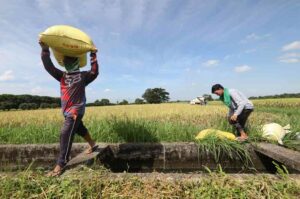THE PHILIPPINES’ agricultural output may have been flat in the first quarter amid the impact of the El Niño dry spell on the sector, especially on palay production, analysts said.
“First-quarter agricultural output in terms of growth should be around 1.8%. It could have been higher, but El Niño contributed to a lack of water, thereby lowering output,” former Agriculture Secretary William D. Dar said in a text message.
If realized, this would be slower than the 2.1% year-on-year growth in the value of farm output in the first quarter of 2023, but faster than the 0.7% expansion in October-to-December 2023.
Agriculture accounts for about a tenth of gross domestic product and about a quarter of all jobs. The Philippine Statistics Authority will release first-quarter agriculture and fishery production data on May 8.
“The overall growth may register a positive figure, but it may remain flat — close to 0.5-1%, mirroring 2023 figures,” Roy S. Kempis, director of the Center for Business Innovation at Angeles University said in a Viber message.
Raul Q. Montemayor, national manager of the Federation of Free Farmers, said farm output could have contracted amid dry conditions.
“Climatic disturbances have adversely affected agriculture in the past few months, so I would not be surprised to see a decline in overall agriculture growth in the first quarter,” he said in a Viber message.
He said the impact of the weather event is expected to last until this quarter.
“We will see the total effects only when the situation normalizes, probably in the second semester,” he added.
As of April 30, agricultural damage from El Niño had reached P5.9 billion, according to the latest bulletin from the Department of Agriculture (DA).
The agency said volume losses of farm goods had reached 255,467 metric tons (MT), with rice being the most affected crop, accounting for 53.2% of the total.
The state weather bureau said while the El Niño event is weakening, its effects are expected to last until August.
RICE, CROPS MOST AFFECTEDMr. Dar said rice production have declined during the dry season harvest.
“This will affect our rice supply during the lean months of the year. The same for corn — it is affected by El Niño, thereby output will be lower,” he said.
“(The) government must invest more in water-harvesting structures including solar-powered irrigation systems, as well as the construction of more efficient irrigation systems,” Mr. Dar added.
Crops account for over half of the value of farm output in the country, with palay or unmilled rice’s share at 30% and corn at 5.5%.
“The lack of rain starting February and the rise of temperature towards March 2024 were detrimental to the crop sector,” Mr. Kempis said.
He added that the dry spell hit crops, mainly rice and corn, during their maturing and reproductive stages.
“El Niño affected production during the reproductive and maturity stages in palay. In corn, one end (the tips) of many corn ears where the silks come out were damaged such that these were considered rejects,” Mr. Kempis said, citing DA reports.
Agriculture Assistant Secretary and Spokesperson Arnel V. de Mesa said the country’s unmilled rice production is unlikely to fall below 20 million MT this year despite the dry weather.
“Our target is similar or a little over what we harvested last year of 20.06 million MT,” he told BusinessWorld.
Meanwhile, the fishery sector likely continued to contract in the first quarter, the analyst said.
“With the fishing ban in effect partly covering the first quarter plus the limited access to traditional fishing grounds in the West Philippine Sea, output ii the fishery sector will not produce positive results,” Mr. Kempis said.
Fishery production in the first quarter was affected by both El Niño and the closed fishing season, Mr. Dar said.
The government imposes a three-month closed season to repopulate certain fish species. Fishing bans are declared in Northern Palawan, Ilocos, Negros Occidental, Capiz and Cebu in the fourth quarter.
Closed seasons are authorized by Republic Act No. 8550 or the Fisheries Code.
The DA approved a fish import quota of 25,000 MT for the fourth quarter to boost supply.
LIVESTOCK, POULTRYAs for livestock and poultry, Mr. Kempis said higher temperatures might have had a limited impact on these sectors.
“While temperatures could affect backyard production of livestock and poultry, these are more stable (nonfluctuating); with good management of livestock and poultry, production in the backyard sector will be a source of growth,” he said.
However, Mr. Dar said the African Swine Fever (ASF) remains a major problem for hog farmers. “Intensity management and control is needed,” he added.
President Ferdinand R. Marcos, Jr. said earlier the government would roll out ASF vaccines from Vietnam by June or July.
As of April 15, there were four regions included in the red zone spanning five provinces or 10 municipalities, according to the Bureau of Animal Industry (BAI). Red zones are areas with confirmed ASF outbreaks,
Gregorio A. San Diego, Jr., chairman emeritus of the United Broiler Raisers Association, said poultry production declined during the period, resulting in higher imports.
“There is a dip in performance especially for conventional poultry houses, but our bigger problem is the oversupply for broiler and more so with eggs that have resulted in very low farmgate prices,” he said in a Viber message.
Chicken imports totaled 128.51 million kilograms in the first quarter, according to the BAI. Shipments of turkey stood at 307,835 kilos and duck at 33,375 kilos. — Adrian H. Halili
